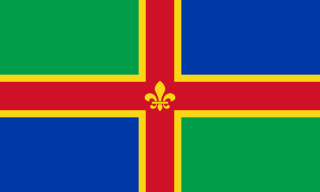
A flag is a piece of fabric with a distinctive design and colours. It is used as a symbol, a signalling device, or for decoration. The term flag is also used to refer to the graphic design employed, and flags have evolved into a general tool for rudimentary signalling and identification, especially in environments where communication is challenging. The study of flags is known as "vexillology" from the Latin vexillum, meaning "flag" or "banner".

The flag of the Netherlands is a horizontal tricolour of red, white, and blue. The current design originates as a variant of the late 16th century orange-white-blue Prinsenvlag, evolving in the early 17th century as the red-white-blue Statenvlag, the naval flag of the States-General of the Dutch Republic, making the Dutch flag perhaps the oldest tricolour flag in continuous use. It has inspired the Russian and French flags. During the economic crisis of 1930s the old Prince's Flag with the colour orange gained some popularity among some people. To end the confusion, the colours red, white and blue and its official status as the national flag of the Kingdom of the Netherlands were reaffirmed by royal decree on 19 February 1937.

The flag of Germany or German flag is a tricolour consisting of three equal horizontal bands displaying the national colours of Germany: black, red, and gold. The flag was first adopted as the national flag of modern Germany in 1919, during the Weimar Republic, until 1933.

Orange is the colour between yellow and red on the spectrum of visible light. Human eyes perceive orange when observing light with a dominant wavelength between roughly 585 and 620 nanometres. In painting and traditional colour theory, it is a secondary colour of pigments, created by mixing yellow and red. It is named after the fruit of the same name.

The national flag of the Kingdom of Belgium is a tricolour of three bands of black, yellow, and red. The colours were taken from the coat of arms of the Duchy of Brabant, and the vertical design may be based on the flag of France. When flown, the black band is nearest the pole. It has the unusual proportions of 13:15.

The flag of South Africa was designed in March 1994 and adopted on 27 April 1994, at the beginning of South Africa's 1994 general election, to replace the flag that had been used since 1928. The new national flag, designed by the then State Herald of South Africa Frederick Brownell, was chosen to represent the country's new democracy after the end of apartheid.

The flag of Austria has three equal horizontal bands of red (top), white, and red. The Austrian triband is based on the coat of arms of the Babenberg dynasty, recorded in the 13th century. It may have seen use in flags from about the 15th century, alongside the black-and-yellow colours of the Imperial House of Habsburg and other insignia of the Holy Roman Empire. It was adopted as a naval ensign and flags of the Grand Duchy of Tuscany and Duchy of Modena and Reggio in the 18th and 19th century respectively, as both were ruled by cadet branches of the House of Habsburg. Since 1918 it has been used as the national flag of the Republic of Austria.

The flag of Vatican City was adopted on 7 June 1929, the year Pope Pius XI signed the Lateran Treaty with Italy, creating a new independent state governed by the Holy See. The Vatican flag is modeled on the 1808 yellow and white flag of the earlier Papal States, to which a papal tiara and keys were later added. The Vatican also refer to it, interchangeably, as the flag of the Holy See.

A tricolour or tricolor is a type of flag or banner design with a triband design which originated in the 16th century as a symbol of republicanism, liberty or indeed revolution. The flags of France, Italy, Romania, Mexico, and Ireland were all first adopted with the formation of an independent republic in the period of the French Revolution to the Revolutions of 1848, with the exception of the Irish tricolour, which dates from 1848 but was not popularised until the Easter Rising in 1916 and adopted in 1919.

The term Pan-African colours can refer to two sets of three colours. Red, yellow, and green are inspired by the flag of Ethiopia. They are used in flags and other emblems of various countries and territories in Africa and the Americas to represent Pan-Africanist ideology. The Rastafarian movement and many Pan-African organisations also often employ the colours for their activities.

The national flag of the Central African Republic was officially adopted in 1958. It has been retained since that time with the same design, four horizontal stripes of blue, white, green and yellow, and a single vertical band of red, with a yellow five-pointed star in the upper left corner.

The national flag of Ethiopia was adopted on 31 October 1912. It conforms to the specifications set forth in Article 3 of the 1995 Constitution of Ethiopia. However, the diameter of the central disc is increased from that of the flag used from 6 February to 31 October 1996. The three traditional colours of green, yellow and red date back to Iyasu V. The current flag and emblem were adopted after the defeat of Ethiopia’s Marxist regimes headed by Mengistu Haile Mariam. The emblem is intended to represent both the diversity and unity of the country. Blue represents peace, the star is said to represent diversity and unity, and the sun's rays symbolise prosperity. The green recalls the land, yellow stands for peace and hope, and red is symbolic of strength.

The national flag of Ghana was designed and adopted in 1957 and was flown until 1962, and then reinstated in 1966. It consists of the Pan-African colours of red, gold, and green, in horizontal stripes, with a black five-pointed star in the centre of the gold stripe. The Ghanaian flag was the second African flag after the flag of the Ethiopian Empire to feature these colours. The flag's design influenced that of the flag of Guinea-Bissau (1973). The flag of Ghana was designed by Theodosia Okoh (1922–2015).

The flag of Rwanda was adopted on October 25, 2001.

The flag of Ukraine is a banner of two equally sized horizontal bands of blue and yellow.

The Senyera is a vexillological symbol based on the coat of arms of the Crown of Aragon, which consists of four red stripes on a yellow field. This coat of arms, often called bars of Aragon, or simply "the four bars", historically represented the King of the Crown of Aragon.

The official flag of Lincolnshire was unveiled at five separate ceremonies across the county on 24 October 2005. The flag was chosen in a popular vote organised by BBC Radio Lincolnshire along with Lincolnshire Life magazine. The winning entry, designed by Lincolnshire-born Michelle Andrews, a web producer at BBC Lincolnshire, was selected from a shortlist of six designs and attracted thousands of votes.
The flag and coat of arms of Kedah are the state symbols of Kedah, Malaysia. Very little distinction is present between the flag and coat of arms of the state, as the flag consists of only a red field with the state arms on the upper hoist.

The flag of the state of Perak, in Malaysia, is a tricolour, made of three equal horizontal bands coloured white (top), yellow, and black (bottom). Adopted on 31 January 1879, it has a ratio of 1:2.

The Medal for Distinguished Conduct and Loyal Service is a South African military medal which was instituted by the Republic in 1987. It was awarded to members of the South African Defence Force for forty years of loyal service and distinguished conduct.



















